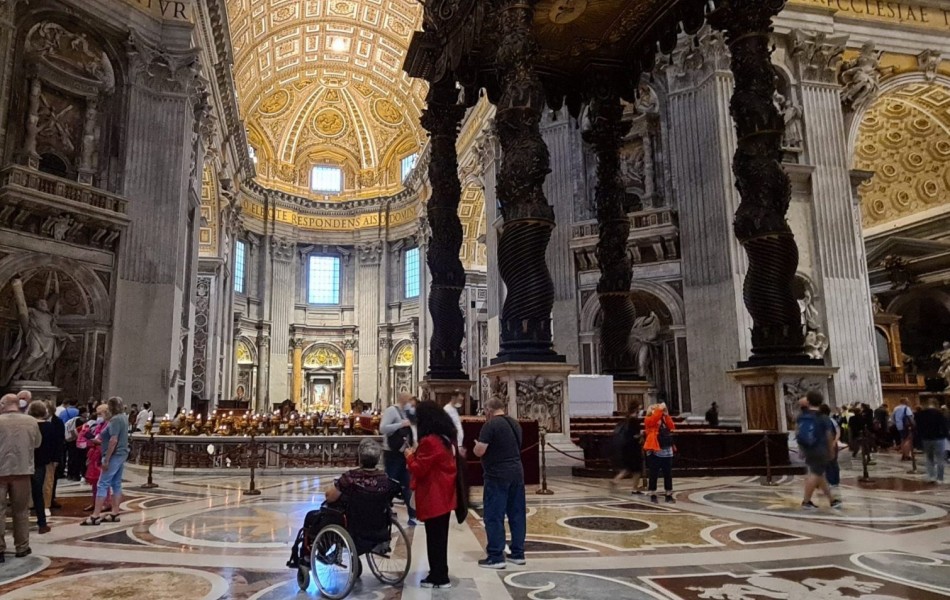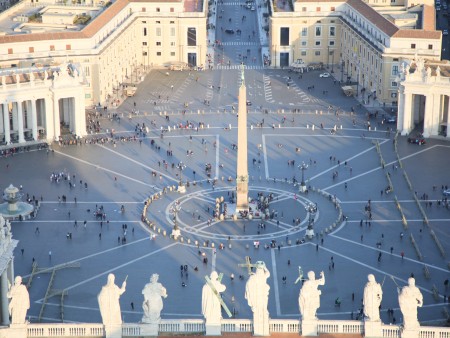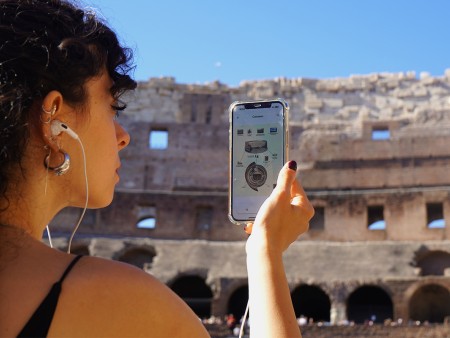New Paths for Seniors and Wheelchair Users for the Jubilee
A more inclusive Rome during the Jubilee: accessible paths for seniors and wheelchairs’ users: St. John’s Piazza, the Holy Door, and the Tiber Waterfront

07 April 2025
Rome Travel GuideFor the Jubilee of 2025, Rome has created wider pedestrian areas and open spaces designed for seniors and those who prefer a slower pace. New benches and shaded seating spots along scenic routes encourage visitors to take breaks, relax, and enjoy the city's beauty at their own rhythm. These additions allow seniors to explore Rome’s grandeur comfortably, whether in bustling piazzas or peaceful corners.
For seniors also using wheelchairs, Rome has improved accessibility with smoother pathways, ramps, and elevators, making it easier to visit historic sites and public spaces. These thoughtful changes ensure that all visitors, regardless of mobility, can enjoy the city’s wonders with ease and comfort.
Don't miss the chance to visit the most famous landmarks of Rome and the Vatican City with us in our Rome Tours for Seniors.
St. Peter’s Basilica Access and the Holy Door open for the 2025 Jubilee
The access to St. Peter's Basilica and the Holy Door in Vatican City has been significantly enhanced to ensure greater accessibility for all visitors, particularly seniors and individuals with mobility challenges. St. Peter’s Basilica, one of the most famous and historically significant churches in the world, serves as the heart of the Catholic Church and the official seat of the Pope. Its construction began in the early 16th century, and over the centuries, it has become a symbol of Christianity, drawing millions of pilgrims and tourists from around the world. The Vatican has ensured that both the Basilica and the Holy Door, traditionally opened during Jubilee Years, are now more accessible than ever.
The pathways leading to St. Peter’s Basilica have been widened and well-maintained, allowing for smooth and easy access for wheelchair users and people with limited mobility. Visitors can now approach the grand entrance without encountering obstacles, ensuring everyone has the opportunity to experience the breathtaking beauty of this sacred space. For those wishing to pass through the Holy Door, a powerful symbol of faith and spiritual renewal, the Vatican has made sure that access is available to all. The entryway has been modified to include ramps and other accessibility features, making it possible for individuals of all abilities to participate in this special tradition.
In addition to these physical upgrades, accessible public restrooms are available nearby, providing essential facilities for visitors with disabilities. The surrounding area has also been redesigned to help improve the flow of pedestrian traffic, minimizing congestion and creating a more comfortable environment for all. St. Peter’s Basilica is easily reachable via public transport, with the Ottaviano Metro Station and various accessible bus routes located nearby. These thoughtful upgrades ensure that St. Peter’s Basilica remains a welcoming and accessible destination, where people of all abilities can connect with its history, beauty, and spiritual significance.
St. John in Lateran new Accessible Square
The recently completed renovation of the square in front of St. John Lateran Basilica, the Cathedral of Rome, has transformed it into a more inclusive and accessible space for all visitors. St. John Lateran holds significant historical importance as it is the oldest basilica in Rome, dating back to the 4th century and serving as the Pope’s cathedral, making it a key religious and cultural landmark. The design of the newly redeveloped square prioritizes ease of movement, with wide, smooth pathways that ensure wheelchair users, people with limited mobility, and seniors can navigate the area comfortably. One of the key features of the redesign is the ample seating provided throughout the square. Strategically placed benches offer visitors a chance to rest and enjoy the magnificent view of the cathedral and its surroundings, making the square an ideal spot for relaxation. The increased open space also eliminates the previous congestion, allowing visitors to experience the area in a more leisurely and less crowded environment.
Another notable enhancement is the inclusion of accessible public restrooms, providing much-needed convenience for visitors with disabilities or those requiring additional support. These toilets are designed to meet modern accessibility standards, ensuring that everyone can enjoy their visit without concerns over facilities.
Additionally, the square is well-connected to public transport, making it even easier for visitors to access. The nearby San Giovanni Metro station, just a short walk away, is fully accessible, allowing people with limited mobility to easily reach the square. This station is part of the Metro Line A, which connects various key locations around the city, making the square both a historical and convenient destination. These thoughtful upgrades ensure that the square is not only a beautiful and peaceful space but also a highly functional and accessible area for all.
The Hidden Gems of Esquilino: A Relaxed, Accessible pathway
The new tourist itinerary, in Rome city center, around the Esquilino district, including the Acquario Romano, is designed with accessibility in mind, making it a great option for seniors and those who prefer a slower pace. The route, which can be comfortably explored on foot in about two hours, passes through green spaces like the Gardens of Piazza Vittorio, offering plenty of opportunities for breaks and rest on benches. The wide, pedestrian-friendly streets allow visitors to move at their own pace, stopping to admire historical sites like the Basilica of Santa Croce in Gerusalemme and the Acquario Romano. This well-planned path ensures that older visitors, including those in wheelchairs, can enjoy the journey without rushing, taking in the beauty of Rome’s hidden gems in a relaxed and accessible way. Moreover, the Esquilino district is centrally located, close to Termini Station and just a short distance from the Roman Forum, making it easy to reach and ideal for a leisurely exploration of the city. This area is also less crowded with tourists and is home to charming local cafés, offering a perfect spot to rest and enjoy authentic Roman flavors.
The via Sacra: Ancient Ruins Become Accessible
The Via Sacra, the most famous road of ancient Rome that runs through the heart of the Roman Forum, has recently become more accessible as part of an ongoing effort to improve pathways for all visitors. This historic street, once the route of triumphal processions and a key artery of the ancient city, now features an alternative route designed to accommodate wheelchair users and seniors with mobility challenges. Thanks to these improvements, visitors can now access some of the Forum’s most important monuments, including the House of the Vestal Virgins, the Temple of Romulus, the Temple of Antoninus and Faustina, the Forum Square, and the Senate. This initiative ensures that a broader audience can experience the rich history of the Forum without being restricted by uneven terrain.
While the ascent to the top of the Palatine Hill remains somewhat challenging due to the natural slope and occasional uneven pavement, further work is being planned to improve accessibility. Currently, the total length of accessible paths in the Forum is 1.5 km, but with ongoing projects, it is expected to expand to 2.0 km, making even more of the site available to visitors with mobility needs.
Additionally, inside the nearby Colosseum, an inclusive route has been established on the first level, covering a large portion of the monument. Dedicated lifts allow seniors and people with limited mobility to reach the second level, ensuring they can fully appreciate one of the world’s most iconic landmarks. These continuous improvements reflect a commitment to making Rome’s most treasured historical sites accessible to all, allowing everyone to immerse themselves in the grandeur of the ancient Rome.
Piazza Pia: A New Restful Stop Between Castel Sant’Angelo and St. Peter’s Basilica
Rome has always been a city best explored at a leisurely pace, and the newly transformed Piazza Pia is an ideal stop for seniors who need frequent breaks. Located between the iconic Castel Sant’Angelo and St. Peter’s Basilica, this beautifully redesigned pedestrian space offers a safe and comfortable place to rest while taking in the city’s rich history and stunning views. Wide, accessible pathways make it easy to navigate at any pace, whether walking slowly or using a wheelchair, and newly installed benches provide plenty of opportunities to sit, relax, and soak in the surroundings. Whether you’re walking with a cane, using a wheelchair, or simply looking for a quiet spot to pause, Piazza Pia makes exploring Rome more enjoyable and inclusive.
The historical significance of this location is remarkable. Castel Sant’Angelo, originally built as Emperor Hadrian’s mausoleum, later became a fortress and papal residence. It was famously connected to St. Peter’s Basilica by the Passetto di Borgo, a hidden elevated corridor nearly 800 meters long. This passage was used by popes as an emergency escape route during times of danger, allowing them to flee from the Vatican to the safety of the fortress. While the Passetto is not always open to visitors, you can still admire its structure running along the fortified walls.
From Piazza Pia, seniors can enjoy some of the most breathtaking views in Rome. The dome of St. Peter’s rises majestically in the distance, while the angelic statues lining Ponte Sant’Angelo create a picture-perfect scene. The area is also home to charming cafés where you can sip a coffee and enjoy a relaxed moment before continuing your journey. Whether you’re visiting Vatican City or strolling along the Tiber River, this new space is designed to be easily walkable at a slow pace, providing a perfect balance of history, beauty, and comfort—making it a must-see for seniors exploring the Eternal City.
Lungotevere: An Enjoyable Pathway along the Tiber Waterfront
The newly inaugurated ”Lungotevere delle Navi” park represents an important step in the revitalization of Rome’s riverfront, transforming a once neglected and inaccessible area into a beautiful and fully accessible public space. This project is part of a broader initiative to reconnect the city with the Tiber River, which has been central to Rome’s history for over 2,700 years. Known in antiquity as the Tiberis, this river was the lifeblood of the Roman Empire, providing water, trade routes, and natural defenses. Along its banks, the first settlements of Rome flourished, and over the centuries, the Tiber became a vital corridor for commerce, culture, and urban development. However, in modern times, parts of the riverfront fell into disrepair, becoming underutilized and disconnected from the city’s daily life.
Lungotevere delle Navi is the first of several planned accessible parks, designed to restore these neglected areas and return them to the community. With a focus on accessibility, sustainability, and urban integration, this new green space enhances the rich natural landscape of the Tiber’s banks while creating an inviting environment for relaxation, tourism, and educational activities. The park features wide, smooth pathways, making it fully accessible for wheelchair users and seniors with limited mobility. Strategically placed seating areas allow visitors to rest and take in the stunning views of the river, while well-maintained green spaces contribute to a peaceful and enjoyable atmosphere.
Beyond accessibility, the park is also a model of environmental sustainability, with efforts focused on preserving and enhancing the historic tree-lined landscape along the river. The design seamlessly integrates the natural beauty of the Tiber with modern urban needs, creating a space that feels both timeless and contemporary. The opening of Lungotevere delle Navi signals a renewed commitment to reconnecting Rome with its ancient river, transforming it from a forgotten waterway into a lively and inclusive space for all. This project is not just about restoring a piece of the city’s history—it’s about shaping its future, ensuring that Rome’s relationship with the Tiber remains as vital as it was in ancient times.
Our categories:
You may also be interested ...

Vatican Private Tour with Sistine Chapel & St. Peter's Basilica: Renaissance’s Wonders
Private tour
Discover with a skip the line Private Vatican Tour the Sistine Chapel, Vatican Museums and St Peter’s Basilica
starting from: € 275

Colosseum Guided Audio Tour with Roman Forum and Palatine Hill
Private tour
Discover Ancient Rome’s secrets and history with our immersive Colosseum guided audio tour, rich in image and content
starting from: € 51 € 42